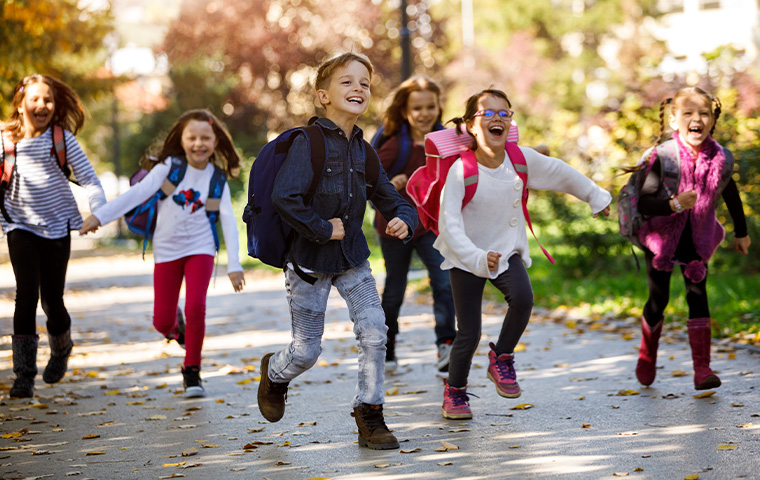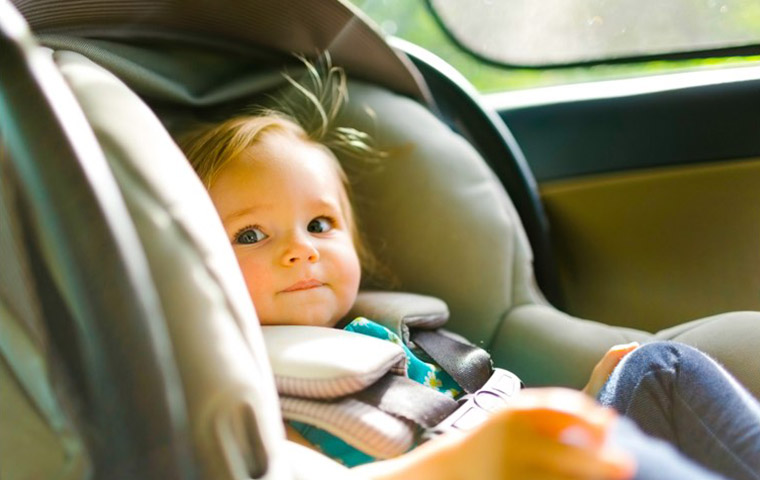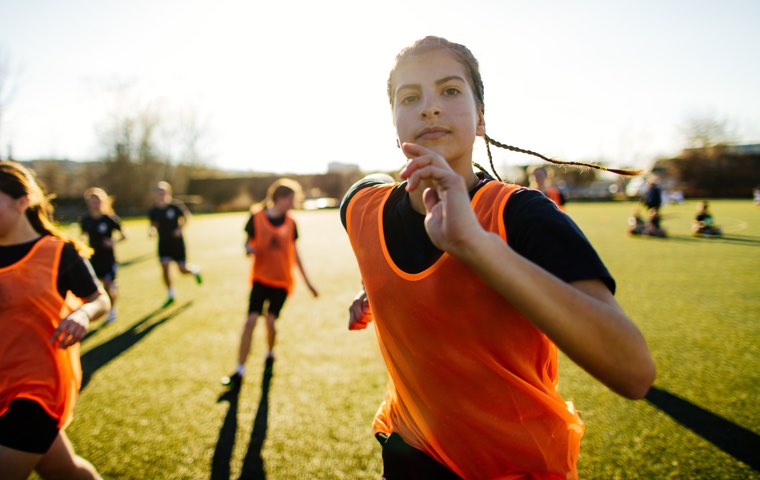Learning to ride a bike is an important part of growing up. And helping your child get ready to go out on her (or his) own—on foot or a bike—is a big step for the entire family. Practicing pedestrian safety and bicycle safety skills with your child can give you peace of mind and be lots of fun for everyone. We’re here to help with tips and guidelines below.
Getting Started with Bike and Pedestrian Safety
Anytime you’re walking or cycling with your child, tell her about the safety choices you’re making. Start by letting her know what you’re doing and how it’s helping keep her safe. Then ask her to copy you. Eventually, you can let your child be the leader and watch her share her bike safety skills with others. Give her plenty of praise when she gets it right and help her when she doesn’t.
In general, it’s safer to walk or ride during the day and with someone else. If you must be out at night, be sure to bring a flashlight. And make sure you’re following the Texas bicycle safety law that requires all bikes to have a white light on the front and a red light or reflector on the back for nighttime riding.
Bike Safety Check Before Every Ride
- Make sure your child’s helmet and bike fit their body properly. (Since children grow fast, it’s a good idea to get a complete helmet and bicycle safety check twice a year. Ask your local bike shop for help.)
- Check bike tires for proper inflation.
- Tuck in shoelaces and pant legs so they don’t get caught in the bike chain.
- Strap items securely to a bike rack behind the seat or put them in a backpack or bike basket.
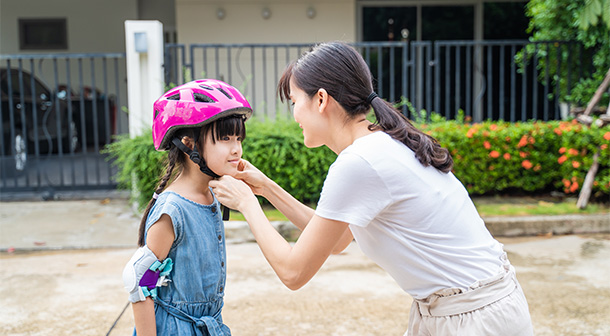
Top 5 Pedestrian and Bicycle Safety Tips
-
Don’t blend in! Make sure you’re easy for others to see.
Kids are small and their movements are often unpredictable. They can be especially hard to see in the early morning, around sunset, when it’s rainy or foggy, and after dark. To help drivers, other cyclists, and pedestrians see your child, have her wear brightly colored clothing, backpacks, hats, or jackets. If possible, have your child wear items with reflective materials or add reflective tape. If she rides a lot, you might want to buy a bike safety vest or harness.
-
Be aware of your surroundings.
Bike and pedestrian safety require kids to stay alert because you never know what others will do that could put them in dangerous. Drivers and cyclists do not always follow the rules or watch out for others. So, it’s important to teach your child to always pay attention to what’s going on around her and to watch out for moving vehicles. When you’re walking or riding with your child, be sure to put away your cell phone and headphones or earbuds until you reach your destination.
-
Walk or ride where it's safe.
If you’re walking, use the sidewalk. If there isn’t one, walk on the left side of the road. Always walk facing oncoming traffic so you can see cars coming toward you and drivers can see you.
If you’re riding a bike, be sure to follow these bike safety tips:
- Use dedicated bike safety lanes and paved shoulders wherever possible.
- Ride single file, one person per bicycle.
- Stay to the right and move in the same direction as traffic.
- Use hand signals so drivers and cyclists know what you’re going to do.
Bike Hand Signals
- Always keep one hand on your handlebars.
- Signal that you’re turning left by holding your left arm straight out from your body.
- If you’re turning right, bend your left arm straight up. In Texas, you can also signal a right turn by holding out your right arm straight out from your body.
- To show that that you’re stopping or slowing down, bend your left arm down with your hand flat and facing backward.
Remember: Texas law requires cyclists to use hand signals.
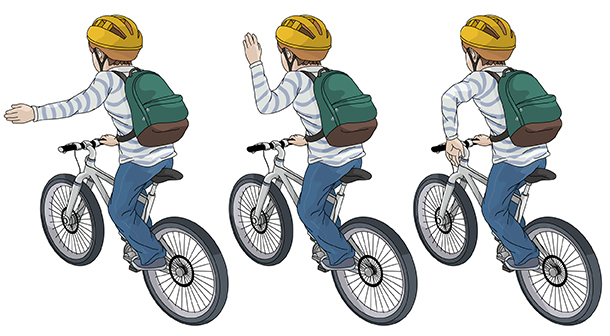
Bike hand signals in order: Turning Left Signal, Turning Right Signal, Slowing Down and Stopping Signal
-
Keep an eye out for pedestrian and bike safety hazards.
As you’re walking or riding your bike, be on the lookout for anything that might cause you to trip, swerve, or fall. This could include other walkers, animals, rocks, potholes, toys, trash, broken glass, and people opening their car doors. If you’re with others and see an issue, be sure to give them the heads up too. And, of course always, be on the lookout for moving vehicles.
Need parenting help now?
The Texas Parent Helpline is available 24/7.
- Call 833-680-0611
- Chat with us
- Text 833-680-0611
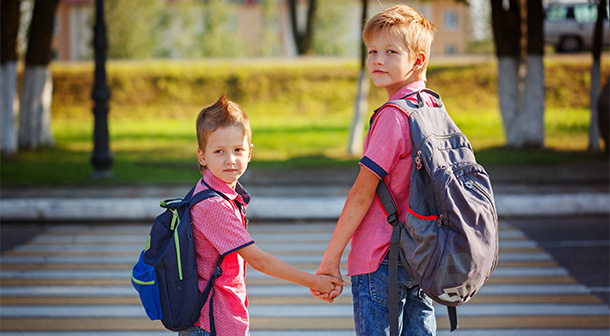
-
Be extra careful at street crossings.
Knowing where, how, and when to cross the street is important for pedestrian safety and bike safety. Drivers often can’t see walkers or riders because of blind spots. The area just in front of a bus or other large vehicle is a blind spot for the driver. It is better to always let them go first and then cross the street.
Where to Cross
Cross the street only at corners, crosswalks, and stoplights. Never cross in the middle of the street or between parked cars.
How to Cross
- Stop completely at the corner or crosswalk.
- Look Left–Right–Left for approaching vehicles, then look in front of and behind you.
- Walk—don’t run—or ride across the street.
When to Cross
- Wait to cross until all bikes and vehicles have stopped.
- Never assume someone else sees you. Make eye contact with each driver or cyclist and wait until you get a nod, smile, wave, or some other sign that they will wait for you to cross.
- If there’s a walk signal, wait and follow the signal directions.
- Cross only when you’re sure the intersection is clear.
If you are cycling and don’t feel comfortable riding your bike through an intersection, pull all the way to the right and get off your bike. Then walk your bike through the intersection from corner to corner.

Can My Kid Ride on the Sidewalk?
Yes, you can ride a bike on a sidewalk in Texas, unless a local government restricts or prohibits it. So, it’s best to check local ordinances. Be sure your child understands the following sidewalk bike safety rules before they take off.
Sidewalk Bicycle Safety
- Ride in the same direction as traffic and more slowly than you would on the street.
- Check for vehicles backing out of or turning into driveways to make sure they see you.
- If someone is walking or riding toward you on the sidewalk, make sure they see you by ringing a bell and staying to the right as you pass.
- If people have their backs to you, ring your bell and tell them you are passing on the left.
Walking and Cycling to School Alone
How Do I Know When My Child is Ready?
Kids under the age of 10 usually need adult supervision when walking or riding their bike to school. Below are tips to help you decide if your child is ready to head out alone.
- Do she have the physical strength and stamina to walk or ride the entire way to school?
- Can she follow pedestrian safety and bicycle safety laws?
- Will she notice oncoming vehicles quickly, understand how far away they are, and correctly judge how fast they are moving?
- Does she have the ability and patience to stop and wait for traffic?
- Can she resist distractions or temptation to follow friends who aren’t behaving safely?
- Does she fully understand risk and danger? Keep in mind, most kids don’t have a realistic sense of danger until they are about 8 years old.
- Does she understand “stranger danger” and know how to react safely around people they don’t know?
If your child has mastered the above, she is most likely ready to head out on her own.

How to Make Walking or Cycling to School as Safe as Possible
Traveling in a group of two or more is usually safer so it’s best that kids walk or bike to school together. Many neighborhoods and school communities have organized groups for going to and from school, such as a Walking School Bus or a Bike Train. Students meet at a specific time and follow a safe route to school with a parent’s or caregiver’s supervision. To find a Walking School Bus, Bike Train, or other group, look for groups on social media or check with your child’s school for neighborhood email lists. If a group doesn’t exist, you can work with other families to create your own. Make sure you have at least one adult or older child who is experienced in walking or bicycling to school and understands bike and pedestrian safety.
To find the safest route to school, look for the one with the least amount of traffic and slow speed limits. Look for streets that have sidewalks, bike paths, or a dedicated bicycle safety lane that is separated from auto traffic. A route that has the fewest and safest street crossings is ideal. If your child must cross streets, try to plan their crossing on quieter, low-traffic streets where there are stop signs or traffic lights. Keep in mind that a longer route may be safer than a shorter one.
Now Take Off and Have Fun!
We hope these pedestrian and bicycle safety tips will help you and your child feel safe whether she is heading out on a bike or on foot. Practicing bike safety and pedestrian safety is a great way to connect with your child as she builds the skills she needs to be safe and independent.


